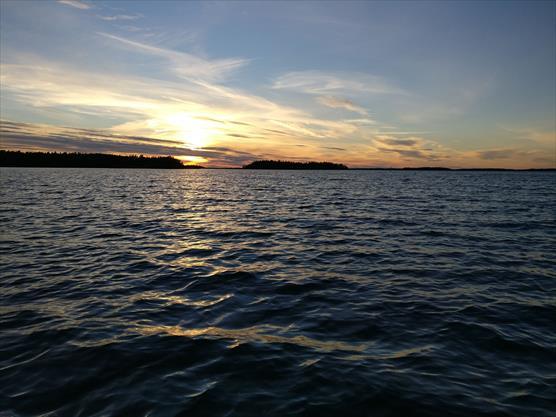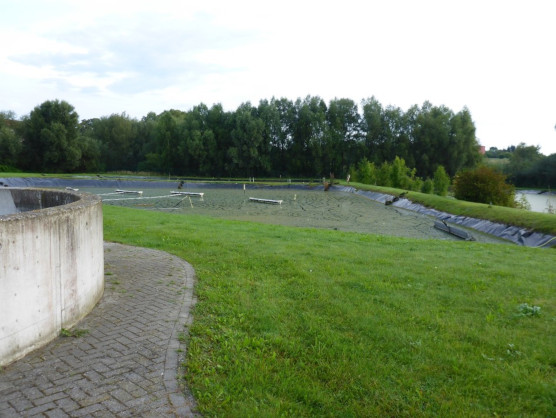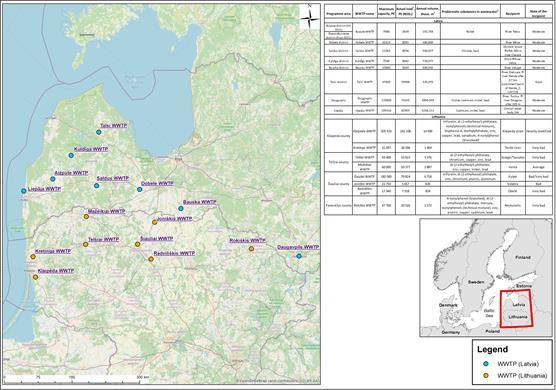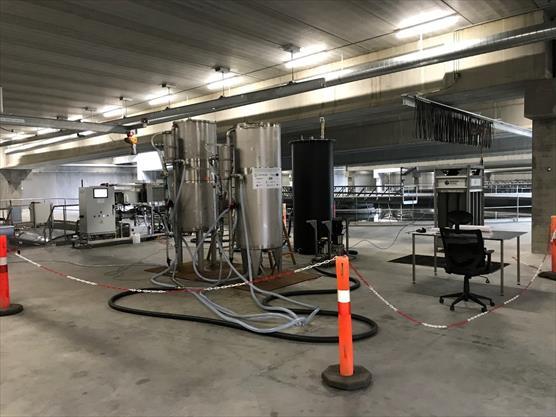What´s new in Baltic Sea Pharma Platform?
Authors: Lauri Äystö and Noora Perkola, Finnish Environment Institute, BalticPharma(at)syke.fi
During spring 2021, the Baltic Sea Pharma Platform lead was transferred from the Swedish Environment Protection Agency to the Finnish Environment Institute (SYKE). As the new lead, SYKE aims to reactivate the platform and keep it active throughout the year. This newsletter is the first step in this process.

Archipelago sea. © Photo: Lauri Äystö.
BSR Pharma
The Baltic Sea Pharma Platform (BSR Pharma) aims to promote knowledge transfer and the implementation of measures to limit the emissions of pharmaceutical residues into the environment. BSR Pharma also offers a platform for project development.
BSR Pharma was launched in 2017. At roughly the same time, UNESCO and HELCOM published a status report: Pharmaceuticals in the aquatic environment of the Baltic Sea region. The report highlighted the widespread occurrence of pharmaceuticals in the BSR environment, such as the high detection frequencies of carbamazepine in Baltic Sea water samples, and gave a number of recommendations on future research projects and how emissions into the BSR environment could be mitigated. The compilation of analytical data and recommendations laid ground for future projects in the field.
Activities within the BSR Pharma rely on the activity of its participants and projects in the field. Projects MORPHEUS, CWPharma, MicroWasteBaltic and GrePPP, and, undoubtedly, many others, played an important role in the BSR Pharma during 2017–2020.
New leaders
From its launch in 2017 until 2020, the platform was led by the Swedish Environment Protection Agency (SEPA). At the beginning of 2021, the lead responsibility was transferred to the Finnish Environment Institute (SYKE). The new platform leaders (Lauri Äystö & Noora Perkola) have both worked in the field of pharmaceuticals in the environment (PiE) for several years. Noora was the CWPharma project leader, while Lauri took part in the project as an activity leader. Both have participated in several Finnish projects in the field.
The transfer of the lead responsibility coincided with the finalization of the last platform project (CWPharma). Thus, one of the short-term goals of the new platform leaders is to identify the most relevant ongoing projects and potential project consortia in the region. To help identify relevant projects, and to let platform participants have a say on how the platform is developed, a questionnaire was launched in June 2021.
Responses to the questionnaire
The questionnaire received altogether 18 replies. While the quantity of respondents was not beyond comprehension, their quality was. Several new and ongoing projects were highlighted for SYKE, accompanied by ongoing processes, such as awareness raising, UWWTD revision, and stakeholder dialogues. This newsletter was compiled in cooperation with some of these new and ongoing projects.
Moreover, every respondent wanted to keep receiving information about the BSR Pharma. The aspects given highest priority within the PiE field were API occurrence and risks, environmental legislation, and emission reduction measures. Over 50% of the respondents also showed an interest towards antimicrobial resistance. Over 80% of the respondents wished to receive a platform newsletter. Electronic meetings were given a slight preference over physical ones. To accommodate this, we aim to organize a webinar / project development workshop at the end of the year.
Your input is needed
To help us as the new leaders of the BSR Pharma, we invite you to bring any ongoing or upcoming projects and projects still in their development phase to our attention! As SEPA did before us, we will rely strongly on participation from projects and individuals working in the field.
_____________________________________
Call for interested stakeholders – be part of the future REPHIRA consortium
Authors: Alena Kaiser, Rostock University, alena.kaiser(at)uni-rostock.de,
Jens Tränckner, Rostock University, jens.traenckner(at)uni-rostock.de
The Baltic Sea constantly receives pharmaceutical loads emitted not only in the urban coastal areas, but also upstream. REPHIRA aims to focus on these typically rural areas to support the European Zero Pollution Goal and is searching for future project partners!

Common rural wastewater treatment plant: SBR with purification pond. © Photo: A.Kaiser 2018.
Background – Where is the problem?
For reducing the emission loads of human pharmaceuticals and other emerging contaminants, most Baltic Sea Region (BSR) countries realised that an upgrade of the largest coastal Waste Water Treatment Plants (WWTPs) is inevitable in the future. The first concepts for the implementation of advanced treatment techniques have been initiated by various projects within the BSR. However, in the typically rural hinterland, emissions from small WWTPs and not yet clearly identified point sources must be regarded, too. These upstream sources have a significant impact especially on the small rivers and streams and their accumulated impact on large water bodies, including the Baltic Sea itself, should also be taken into consideration. However, the implementation of advanced treatment in those plants is challenging for economical, technical and operational reasons. So, a well-reasoned prioritisation of feasible end-of-pipe measures must be accompanied by other mitigation measures, including source control. Besides, regional stakeholders responsible for future prioritisation and decision-making have expressed a need for harmonized approaches in monitoring concepts, and the data handling and assessment of emerging contaminants both at WWTPs and in the environment.
Aim of REPHIRA – What is the project for?
The partners of the currently running Seed Money project REPHIRA – financed by Interred Baltic Sea Region - focus on rural areas in the BSR and are developing a concept for the future main project. To achieve a sustainable and comprehensive progress in reducing pharmaceutical emissions in rural areas (= REPHIRA), the different needs expressed by interviewed stakeholders and requirements will be translated into tasks relevant for our regarded target groups. Generally, we can differentiate between three levels of action: International, regional and local. At the international level, the Baltic Sea Region is defined by the catchment area and all countries are involved in environmental developments via the HELCOM and EU-wide directives. Even though common frameworks exist, their handling and implementation is diverse, especially relating to emerging contaminants. Therefore, we intend to stimulate new and support already existing dialogues by introducing recommendations and good practices to improve existing approaches. At the regional level, the actual river system analysis to understand deficits, drivers and impacts, as well as a consistent prioritisation of implementation measures, is the main challenge. Here, we intend to develop helpful and widely applicable decision support tools. Within each region, we intend to identify suitable case study areas, where the local actors should be brought into an early dialogue process, which also includes the adequate commitment of the main polluters. In rural areas, potentially relevant emitters are large health care facilities, tourism and pharmaceutical related industry. In some cases, source control measures at hot spots may be constructive, while, in other cases, an economic support to central treatment measures may be more suitable. In selected case studies, actual treatment technologies will be planned and tested. All over the different levels of action, the dialogues and inter- + intra-disciplinary collaboration are the core of the future project, to design practicable tools and methods for the whole BSR.
The consortium – Who would participate?
In the seed money project, strong partners from previous and ongoing successful Interreg projects are working together, namely SYKE, Kristianstad University, Gdansk Technical University and Rostock University supported by the Danish and German EPAs. For the forthcoming main project, the consortium will be extended. We seek partners who are responsible for decision-making in the field of regulation, monitoring concepts and data evaluation, environmental risk assessment regarding emerging contaminants or AMR at the local or regional level.
In that way, we intend to adapt future project activities to the actual needs and design useful tools for practice. Exemplary activities could include conducting workshops and trainings, as well as coordinate dialogues in professional round tables, where e.g. experts in data evaluation, monitoring concepts or environmental risk assessment/ecotoxicology will work together. For local case studies, WWTP operators are welcome, too.
At the same time, we would appreciate gaining interested partners from Estonia, Lithuania and Latvia to have a more complete picture of environmental heterogeneity within the Baltic Sea Region. Namely, national and regional EPAs are encouraged to bring in their experience, needs and willingness to actively join the team.
If you believe that you are the partner we are referring to, you are welcome to contact us for more information about the contents as well as an initial talk to get to know each other and to exchange ideas and expertise for a fruitful cooperation!
_____________________________________
Presence of pharmaceuticals in wastewater studied within a large-scale project in the Baltic states - Latvia and Lithuania
Author: Maruta Vehi, Latvian Environment Geology and Meteorology Centre, maruta.vehi(at)lvgmc.lv
To study the pollution of pharmaceutical active compounds in wastewater and water bodies in Latvia and Lithuania, scientists, researchers and experts from both countries have been working together under a joint project for almost two years from now. The project “Pharmaceuticals in wastewaters–levels, impacts and reduction” (MEDWwater) is financed by the EU, and the search for a solution to reduce the pollution caused by pharmaceutical products is among the project’s key goals.
The project aims to increase the efficiency of pharmaceutical substances pollution management and to increase cooperation between governmental institutions and wastewater treatment plant operators.
In Latvia and Lithuania, information and the monitoring of pharmaceuticals in the environment are very limited. Most data on environmental levels in both countries are collected in different projects, therefore, project MEDWwater will help to fill knowledge gaps. There is a need to collect the information to understand and evaluate certain pharmaceuticals regarding their environmental concentrations in various sizes of WWTP and the resulting levels of risk.
Previously, Latvia and Lithuania participated in two international projects under which research about the pollution of pharmaceutical active compounds were implemented (CWPharma and Morpheus). The MEDWwater project is a continuation and the first big-scale research carried out in Latvia and Lithuania at the same time. Within this project, the concentration of substances will be established in water both before and after wastewater treatment plants, the environmental impact will be determined, and solutions will be searched for in order to improve the situation.
The project manager researcher Ieva Putna-Nīmane from Daugavpils University Agency “Latvian Institute of Aquatic Ecology” points out that this kind of pollution is a topical issue. “Although there are some clues and data from the previous projects suggest that there is pollution with pharmaceutical active compounds in the territory of Latvia and Lithuania, as we use medications, we cannot make any conclusions about its scale yet. Therefore, we are glad that the project MEDWwater was supported and has been launched.” She informed that, within the project, 25 pharmaceutical active compounds will be identified, the establishment of concentration of which in wastewater is recommended by the EU, together with substances used by the inhabitants of Latvia and Lithuania in comparatively large amounts. At the end of the project after studying the data obtained, the scientists will draw conclusions about the harm that the presence of pharmaceutical active compounds may cause to the environment.
Since February 2021, MEDWwater project partners, in close cooperation with environmental authorities, were working on the selection of relevant municipal wastewater treatment plants (WWTPs) and water bodies (wastewater recipients) in Lithuania and Latvia for further investigations of actual pharmaceuticals loads. Based on the agreed upon selection criteria, experts from Klaipėda university (LT) and Latvian Environment, Geology and Meteorology Centre (LV) have identified urban wastewater agglomerations of more than 2 000 population equivalent located in both countries. When selecting WWTPs, the priority was given to the ones located in Lithuania-Latvia shared River Basin Districts of Venta and Lielupe rivers and coastal areas. Additionally, in-depth analysis of existing strategic environmental documents and available monitoring data was completed in order to identify WWTPs, characterized by less effective treatment technologies and needed to be upgraded in the nearest future. The quality of the treated wastewater and presence of hazardous substances in waste waters during 2017–2019 monitoring period were also considered. In total, 16 WWTPs (8 from LT and 8 from LV) were selected for further characterization and deeper research during the next MEDWwater implementation stages.

WWTPs in Latvia and Lithuania chosen for closer investigation. (Click
here to open pdf-file and zoom).
The first samples have been collected in July 2021, but the second sampling campaign will take place in December 2021. The chemical analysis of the collected samples will be performed by using state-of-the-art equipment of the Coastal Environment and Biogeochemistry Laboratory at the Marine Research Institute, Klaipėda University.
In cooperation with experienced foreign experts, recommendations and technical solutions for a better removal of pharmaceutical active compounds will be provided to two operators of wastewater treatment plants. Having summarised the project results, experts will prepare recommendations for wastewater monitoring. One of the project activities, the strategic document “Recommendations for wastewater treatment plants”, will allow a better management of nature resources not only within the Programme’s territory but also on a national scale in Latvia and Lithuania.
Along with the scientific research part, the project also includes an information, education and communication campaign about the adverse effect of pharmaceuticals on the environment and how to dispose of drugs after their expiration date or when they are not used.
The project gathers scientists, environmental experts and other specialists from Daugavpils University Agency “Latvian Institute of Aquatic Ecology”, the Latvian Environment, Geology and Meteorology Centre, Kurzeme Planning Region, State Agency of Medicines, State Medicines Control Agency under the Ministry of Health of the Republic of Lithuania, and Klaipėda University.
Project in a nutshell
Project duration:
February 1, 2021 – December 31, 2022.
Project budget:
Total projects size is 673 772.88 EUR.
Out of them co-funding of European Regional Development Fund is 572 706.92 EUR.
Project Partners:
Lead Partner – Latvian Institute of Aquatic Ecology Agency of Daugavpils University, www.lhei.lv, in cooperation with 5 partners from Latvia and Lithuania:
Project partner coordinator for MEDWwater project:
- Maruta Vehi, Latvian Environment Geology and Meteorology Centre, maruta.vehi(at)lvgmc.lv
Link to the Programme website www.latlit.eu.
Link to the official EU website www.europa.eu.
This publication has been produced with the financial assistance of the European Union. The contents of this publication are the sole responsibility of Latvian Environment Geology and Meteorology Center and can under no circumstances be regarded as reflecting the position of the European Union.
_____________________________________
CWPharma 2 is getting pharmaceuticals removal in wastewater into reality
Authors: Kai Bester, Aarhus University, kb(at)envs.au.dk
Michael Stapf and Ulf Miehe, Berlin Centre of Competence for Water
CWPharma 2 is the expansion project of CWPharma and focuses on the removal of pharmaceuticals from wastewater, based on the guidelines of CWPharma. The special needs of wastewater treatment plants in the Baltic Sea region for operating ozonation, granular activated carbon treatment and biofilms are in focus.

Pilot for pharmaceuticals removal at Hillerød Forsyning with granulated activated carbon filters (front) and ozonation (behind). © Photo: Jørgen Skaarup.
Emissions of active pharmaceutical ingredients (pharmaceuticals) into the aquatic environment are a topic of growing interest throughout the whole Baltic Sea region, as their presence can have a negative impact on the aquatic environment, as well as on groundwater and drinking water sources. To get a better understanding of the various pathways of pharmaceuticals into the Baltic Sea, the CWPharma project (Clear Waters From Pharmaceuticals) conducted an extensive screening campaign and used the data to set up the Baltic Pharma Load-model (BPL). CWPharma also investigated how these pharmaceutical emissions can be reduced through technical and non-technical measures. The findings were condensed into several guidelines with actionable recommendations for authorities, wastewater treatment plant operators and political decision makers, and are available on the project homepage.
The follow-up project CWPharma 2, which is also funded by the EU’s Interreg Baltic Sea Region Programme, focuses on the practical implementation of the CWPharma “Guideline for advanced pharmaceutical removal” to support WWTP operators in bringing full-scale pharmaceutical removal to life. CWPharma 2 is working on the following four main tasks:
- Fitness check for pharmaceutical removal technology
- Applying recommendations for planning pharmaceutical removal and plant optimization
- Detailed planning and implementation of pharmaceutical removal at WWTP Hillerød
- Filling public awareness gaps identified in the initial CWPharma project
Fitness check for pharmaceutical removal technology
Based on the guideline’s recommendations, a fitness check of WWTPs in the Baltic Sea region will be conducted as a first step towards the implementation of a pharmaceutical removal technology. Technologies such as ozonation or adsorption onto activated carbon are able to remove pharmaceuticals in full-scale. However, each WWTP is unique and can have local boundary conditions that favor or inhibit certain technologies. Additionally, data gaps may present problems, and being aware of them is useful for conducting specific measurement campaigns at an early stage. Examples of potential barriers could be: high fractions of industrial wastewater (an unexpected formation of potentially toxic compounds), sludge disposal routes (sludge containing PAC must be incinerated), or elevated bromide concentrations (formation of carcinogenic bromate during ozonation). High bromide levels can be found in particular at WWTPs in coastal areas, e.g., due to sea water intrusion into the sewers or due to high bromide levels already in the drinking water. However, as bromide is not a commonly monitored parameter, hardly any WWTP operators are aware of this potential obstacle.
To date, CWPharma 2 has conducted a fitness check for around 80 WWTPs within the Baltic Sea region via the distribution of a questionnaire and the analysis of a water sample from the interested WWTPs.
Applying recommendations for planning pharmaceuticals removal and plant optimization
CWPharma’s guideline for advanced pharmaceuticals removal processes provides a condensed overview of relevant and critical aspects when planning or operating a WWTP with a pharmaceutical elimination treatment stage. However, when implemented in practice, further questions may arise (e.g., how exactly to interpret data from monitoring or pre-trial experiments) which affect the planning process or optimal operation of the existing tertiary treatment stage.
Therefore, selected WWTP operators (HSY, HFORS and Kohlia WWTP operator via EVEL) are being supported by implementing the recommended steps of the guideline (Guideline module 2) and conducting a feasibility study on pharmaceutical removal technology. During this process, the guideline will undergo a field-test and feedback from the involved parties (e.g. WWTP operators, water authorities or engineering companies) will be used to update it accordingly. The selected study sites (Helsinki WWTP, FI; Hillerød WWTP, DK; Kohila WWTP, EE) include a broad range of boundary conditions (e.g., WWTP size, combination of pharmaceutical and phosphorous reduction) and, therefore, cover multiple aspects of the guideline.
Additionally, strategies for bromate minimization will be tested at the full-scale ozonation plant coupled with MBBR post-treatment of Kalundborg WWTP. The practical application of the bromate minimization strategy (e.g. catchment assessment for bromide sources, bromate reduction by MBBR post-treatment) will serve as an example for other Baltic Sea WWTPs which also detect high bromide levels in their wastewater.
Detailed planning and implementation of pharmaceuticals removal at WWTP Hillerød
CWPharma 2 is using the pharmaceuticals removal guideline developed in the CWPharma project to support the planning of a full-scale pharmaceuticals removal stage at WWTP Hillerød (DK). Pharmaceutical removal is planned to be operational in 2024, by which time a large hospital for the Copenhagen metropolitan area will be built in Hillerød. The environmental authorities have specified the performance necessary for the WWTP, and the operator HFORS has agreed to tackle the additional hospital pharmaceuticals emissions. HFORS is implementing and conducting the recommended short-term piloting phase (ozonation and treatment with granulated activated carbon) to determine the required design parameters for ozonation, as well as post-treatment for the pharmaceutical removal stage at WWTP Hillerød. The evaluation will be based on relevant water quality parameters, including pharmaceuticals and transformation products analysed by Aarhus University (AU) as well as bioassays recommended in CWPharma’s guideline performed by the German EPA (UBA) and IOS in Poland. The results will be directly fed into the planning process of the full-scale treatment stage and the project will adhere to the various design parameters required by the utility (e.g. ozone dosage, ozone production capacity, oxygen demand, size of reaction tanks, design of post-treatment and cost of operation).
Currently, HFORS has completed extensive testing of ozonation and GAC filtration. Due to the Danish regulations, the measurement program (AU) was expanded from 35 to 55 pharmaceuticals and 20 metabolites.
Filling public awareness gaps identified in the initial CWPharma project
Within the initial CWPharma project, awareness of pharmaceuticals in the environment and the proper disposal of unused pharmaceuticals was found to be quite variable within the Baltic Sea countries. In certain countries (DE, SE, FI), the occurrence and effects of pharmaceuticals are already discussed in mass media (e.g., press, television, print), and communicated through governmental information campaigns. In contrast, much less information on pharmaceuticals in the water cycle is available in countries such as the Baltic States and Poland. This poses a serious obstacle in reducing the overall pharmaceutical load into the Baltic Sea, since, for example, Poland is a major contributor of pharmaceutical loading and public awareness is key for the acceptance of reduction measures (e.g. correct disposal of unused pharmaceuticals, cost of advanced treatment stages on WWTPs).
Thus, within CWPharma 2 it is planned to produce a video about APIs in the environment and the correct disposal of unused pharmaceuticals with a focus on Poland and the Baltic States.
The CWPharma 2 project consortium consists of nine partners from six Baltic Sea countries: Aarhus University (AU), Berlin Centre of Competence for Water (KWB), German EPA (UBA), Kalundborg Utility (Kalfor), the Latvian Institute of Aquatic Ecology (LIAE), Estonian waterworks association (EVEL), the Polish Institute of Environmental Protection – National Research Institute (IOS), Hillerød Utility (HFORS), and the Helsinki Region Environmental Services Authority (HSY). The project is coordinated by Aarhus University. Coordinator is Kai Bester.
More information can be found at: https://projects.au.dk/waterpurification/cwpharma-2/cwpharma-2-main-work/